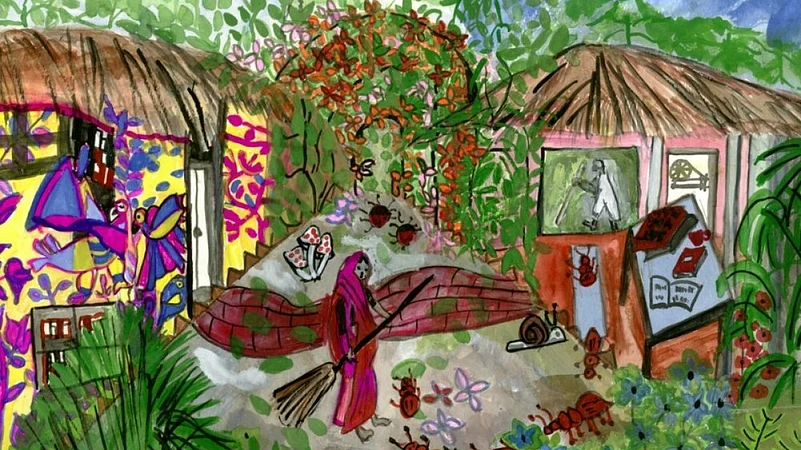For many people in the world, a childhood home is something lost forever. For people fleeing war, natural disaster, and political discord, the instability of their continuing present can overpower longings for the elusive past. Even speaking for myself — coming not from the spectacle of public trauma, but the personal sadness of a broken family and the early loss of parents, combined with the vagaries of a migratory life — certain things just don’t exist anymore: childhood homes, little trinkets and objects eclectically precious to memory. Sometimes, they haunt my writing life, crowding like meaningless yet powerful dreams.
Ruchira Gupta, who is able to return to her childhood home, Gola, in Forbesganj — set in the Bihar foothills, fourteen kilometres from Nepal — turns this beautiful opportunity into a very special series of paintings in an exhibit, “My Forbesganj Garden”, in the virtual viewing room art gallery, curated by Prabhakar Kamble. It’s a striking assemblage of colours, sometimes evocative of the manner of Henri Matisse, that brings this tropical home in the mountain foothills to an evocative narrative life. The use of colour and eclectic lines are beautiful and admirable. It prioritises the inner lives of humans and other life forms in nature beyond the limitations of physical verisimilitude. Prabhakar Kamble touches the heart of these paintings when he says: “Ruchira’s paintings hold no bias — a hummingbird is bigger than a tree.” A seamless continuity between different life forms and even inanimate objects defines these paintings, creating a higher verisimilitude to the subject, this magical place. It is art, as Kamble says, which “recognizes no hierarchy between bird, butterfly, human, or house.”

Ruchira is an acclaimed journalist and activist, who does vital work with vulnerable communities of women. Her NGO, Apne Aap, has a striking history of essential work against intergeneration prostitution in red light areas, especially in Kolkata’s Sonagachhi. She has also been one of the leading activists of the global #MeToo movement. The reality and meaning of labour, particularly that of women, is closely entwined with the evocation of house, nature, and community in these paintings. “Every morning”, begins the story of the very first painting, of a woman in a red sari standing, in a florally evoked courtyard, holding a broom: “Sarita comes to sweep away the leaves in our garden. Her grandmother had migrated with my family from the famines in Rajasthan to the wetlands of Bihar more than a century ago.” It is followed by an imaginative evocation of the “cast iron pump” under the mango tree, the only source of drinking water for the family, as Ruchira’s mother had no faith in bottled water transported over great distances. The wrought iron gates, which are always open, to the “squirrels, snails, birds and even the rats and mongoose” so that they could feel a sense of continuity with the property, are painted unobtrusively, almost part of the twigs and foliage.

The beauty of a childhood home is that it contains objects, trinkets, and possessions of great importance in the past that dwindle, wither, and disappear with time. One of the images represented is Ruchira’s Class Eight sketch book from Delhi Public School, which starts to tell the story of the beginning of the paintings that make up this exhibition. As she comes across these bits of her past, she starts to paint, to give liberty to grief, rage, and despair. “I decide to paint,” she writes, “the grief and anger I feel — at the death of friends from Covid; of the murder and rape of an eight-year-old girl, Asifa; of the arrests and interrogations of my activist friends; of the hunger an death caused by the unnecessarily harsh lockdown among the women and girls that I work with in the red-light areas.”
The labour of writing and the labour of gardening continue next to each other and are articulated in the series of paintings. Next to the writing alcoves of Ruchira and her father, we have the working life of Bahadur, the Nepali caretaker, who “always snaps his fingers near the Tulsi plant before he plucks its leaves;” he says it is to “prepare the plant for the slight pain he will inflict.” Painting and writing long co-existed in this setting, as Kamble reminds us in his curatorial introduction to the exhibition, through the tradition of Phanishwar Nath Renu, who represented the people and landscapes of Forbesganj in the most unforgettable way. “Renu”, Kamble reminds us, “lived for long stretches in Ruchira’s family home and often invited the artist and her childhood friends to ride in his bullock cart sharing stories of the people enmeshed in the River Kosi — their traditions, their subjugation to feudalism, their poverty and their dignity.”

Ruchira’s paintings, with the little accounts accompanying them, continue this tradition of representing life, labour, land, and community, in a seamless continuity with each other. As Shanti goes up the terrace to dry clothes, Ruchira goes up with her and watches the station and the trains, signs of modernity close but distant in the milieu, while her father and brother play carrom on the porch. Fruit sellers, street musicians, and the paan shop make a noisy carnival that draws minute and intricate dabs of colour from Ruchira’s brush, childishly eclectic and yet with a deep, subtle design behind them. Under the banyan tree, the hanuman idol offers faith and community, while the Dalit colony, not far away, offers a different range of colours — both physical and metaphorical. As the painter’s gaze flits between indoor spaces, the organic difference in these communities — between a man reading from a scroll to a community of listeners, and Ruchira’s family eating from beautiful stainless steel thalis, with her grandmother’s name engraved on them — shapes a narrative of scattered, plural aesthetics that offer an invisible, organic unity to this tiny community in Forbesganj, bringing together animals, birds, humans, houses, objects, colour and meandering lines of sheer visual poetry. Even for those of us who have never been to this home, this exhibition feels like a dream homecoming.
(Saikat Majumdar’s most recent novel is The Middle Finger. He tweets at @_saikatmajumdar. Views expressed in this article are personal and may not necessarily reflect the views of Outlook Magazine)


























